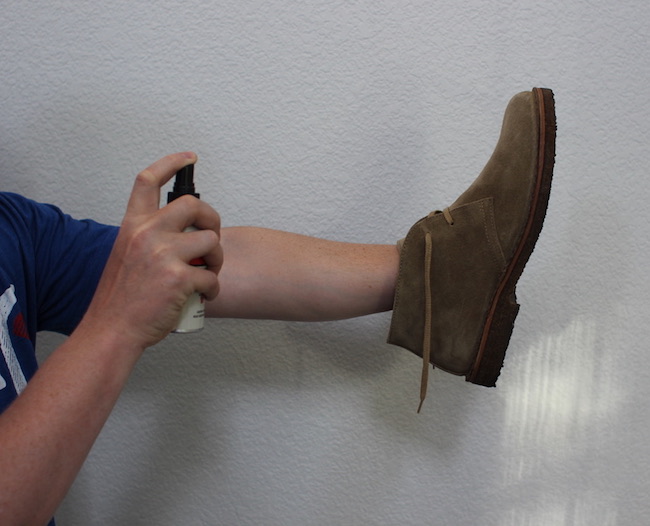
Suede is a leather material used to make belts, watch straps, bags, and more. Men are most likely to encounter it in shoes, like chukka boots. Suede looks and feels good; it adds a unique visual and physical texture to your footwear and accessories.
But for a lot of guys, suede can seem like an intimidating material. You’ve perhaps heard about its delicate nature — that it is easily scratched and scuffed and can be readily damaged by water, grease, and other elements and stains.
While suede isn’t quite as sensitive as it’s been made out to be, it does have its own care routine that differs from other leathers. We’ll get into that in just a bit. But first let’s have a look at what suede is and how it’s made. With both bits of knowledge under your (suede) belt, you’ll be well on your way to eliminating your aversion to this handsome material.
What Is Suede?
If you’re anything like me, it’s possible that the way suede is labeled and marketed has made you think that it’s an entirely different variety of leather (or material altogether!) — something man-made or exotic.
The reality is much simpler: leather is a material made from the hide of any number of animals (cow, sheep, crocodile, etc.), and suede is formed through a process that can be applied to any of those leathers.
Manufacturing leather is a complex process, and different parts of the hide go into making the different kinds of leather — full grain, top grain, bonded, etc. Suede is the softer underside of the hide. Sometimes manufacturers will just flip the hide over, but that creates a stiff material that isn’t generally what you’re going for with suede (though Red Wing does this and calls it “Roughout” leather). Most of the time suede is actually made from a thin middle layer that gets fully cut away from the outer part of the hide. Suede is thinner, more naturally porous (hence being known as a water-sensitive material), and, since it was undercover and protected from the elements when it was part of the animal, not as naturally toughened up as the types of leather taken from the outside of the hide. The result is a napped material that’s softer, lighter, and, more prone to damage.
It should be noted that most suede is made from lamb — while other hides can be used, lamb suits itself best to the process; larger animals create a much shaggier nap, which just doesn’t look as nice.
What About Nubuck?
If you’ve ever shopped around for suede you’ve likely also encountered the term “nubuck” or “nubuck suede.” Rather than coming from an inner layer of the hide, nubuck is actually full grain leather that’s been sanded/buffed to give it a slight nap. So it looks and feels much like suede, but with two main differences: 1) it’s not quite as soft, and 2) it’s a bit more heavy and durable since it’s the outer part of the hide. This also means it doesn’t quite need the same maintenance (though the below routine can still be followed, just less frequently). When it comes to nubuck vs. true suede it’s not really a question of one of them being better or worse; it’s more about what you’re looking for in the material.
How to Care for Suede and Make It Last
As previously alluded to, suede isn’t as delicate as you may think. Scratches can be buffed away, and a little bit of water or dirt isn’t going to permanently ruin your shoes.
But, it does need to be cared for and maintained, just as your other leathers do, albeit with a different process and set of products. The bristles in the brush in your standard leather care kit are usually a bit large to be working on suede, and you definitely don’t want to be using any polish/cream on the material, nor a wet cloth.

So first, get yourself a suede care kit. Any suede-specific kit will come with a small brush (and sometimes a second brush specifically for maintaining the nap) as well as what’s called a suede eraser (or sometimes suede block). It’s basically a large rubber eraser that removes scuffs. And depending on the kit, you may also get a leather protector in the form of a clear spray.
As soon as you crack open your new suede shoes or belt, give it a spray with the protectant.
From there, use the following routine — once a month or so for irregular use; every 1-2 weeks with regular all-day wear — to regularly care for your suede and make sure that it lasts for years to come:
1. Brush
Use the bristle brush to clean off any dirt, sediment, etc. Don’t press too hard and scuff the material — it’s more like the pressure of brushing your teeth than washing dishes. You also want to brush in a single direction to keep the nap uniform.
When you brush, it does appear to change the color some, but that’s just the nap fluctuating (just like what happens when you run your hand over a suede or velvety couch).
2. Erase
If there are specific spots or any stains on the material that didn’t come out with the first brushing, use the eraser to gently scrub them off. Again, use a light pressure. The eraser works great for nearly any stain that isn’t grease (more on that below) as well as scuffs and small scratches.
Grease Stains
One thing that can truly muck up any material — suede included — is grease. One little spot can really ruin the uniform look of a shoe or accessory. With this particular type of stain, there’s one product that does near-miraculous wonders: cornstarch.
Apply a small pile to the stain (be liberal here), allow at least 15 minutes for the cornstarch to sit and absorb the grease (up to an hour or so), and then brush away with your suede brush. One application may very well remove the stain completely. If not, apply cornstarch again and repeat the process until the stain is gone. Give the area a scrub with the eraser, then give it a final brush to fully remove any residue and restore the nap.
Don’t try to use other grease-fighting agents, like dish soap, as they can ruin the material.
Bonus #1: cornstarch can also be used effectively even on old and seemingly set-in stains (though it’s not a guarantee of course).
Bonus #2: cornstarch can be used on any material to remove grease. No more relegating stained shirts to the rag pile.
3. Brush Again

Before and after. On the left you can see a couple small scuffs and the nap is not uniform, giving it sort of a splotched look. After brushing and erasing, on the right, you can see the scuffs are gone and the nap is nice and uniform, giving the shoe a polished look. On the floor you’ll notice the residue/sediment that gets brushed off; it really does make a difference and keeps the material clean.
After you’ve used your eraser, brush the suede once again, in a uniform direction. If your kit comes with a second brush (often called a “crepe” brush), use it here.
4. Spray

Apply a clear protectant by holding the item about arm’s length away and giving it a good spray all over. The material will probably change color some, but don’t worry at all, that will go away.
If your suede gets wet, don’t fret. If it’s just a little bit, let it dry, then give it a brushing. If it got quite wet or muddy, dab it dry with a paper towel, let it dry, and give it a clean. If you’ve been regularly applying the spray, you don’t have much to worry about.
If you do end up with a stain of any kind that you can’t get out yourself with either a brush or eraser (or cornstarch), look for a dry cleaner in your area that does leather/suede.
Again, while suede is not a delicate fabric per se, it is more prone to damage. So you might as well not take chances with how you wear it. In general, do yourself a favor and just don’t put on the suede boots if the forecast calls for inclement weather, or if your agenda calls for a muddy adventure.
If you do that, and follow the maintenance routine described above, your suede products will find years of enjoyable use.







